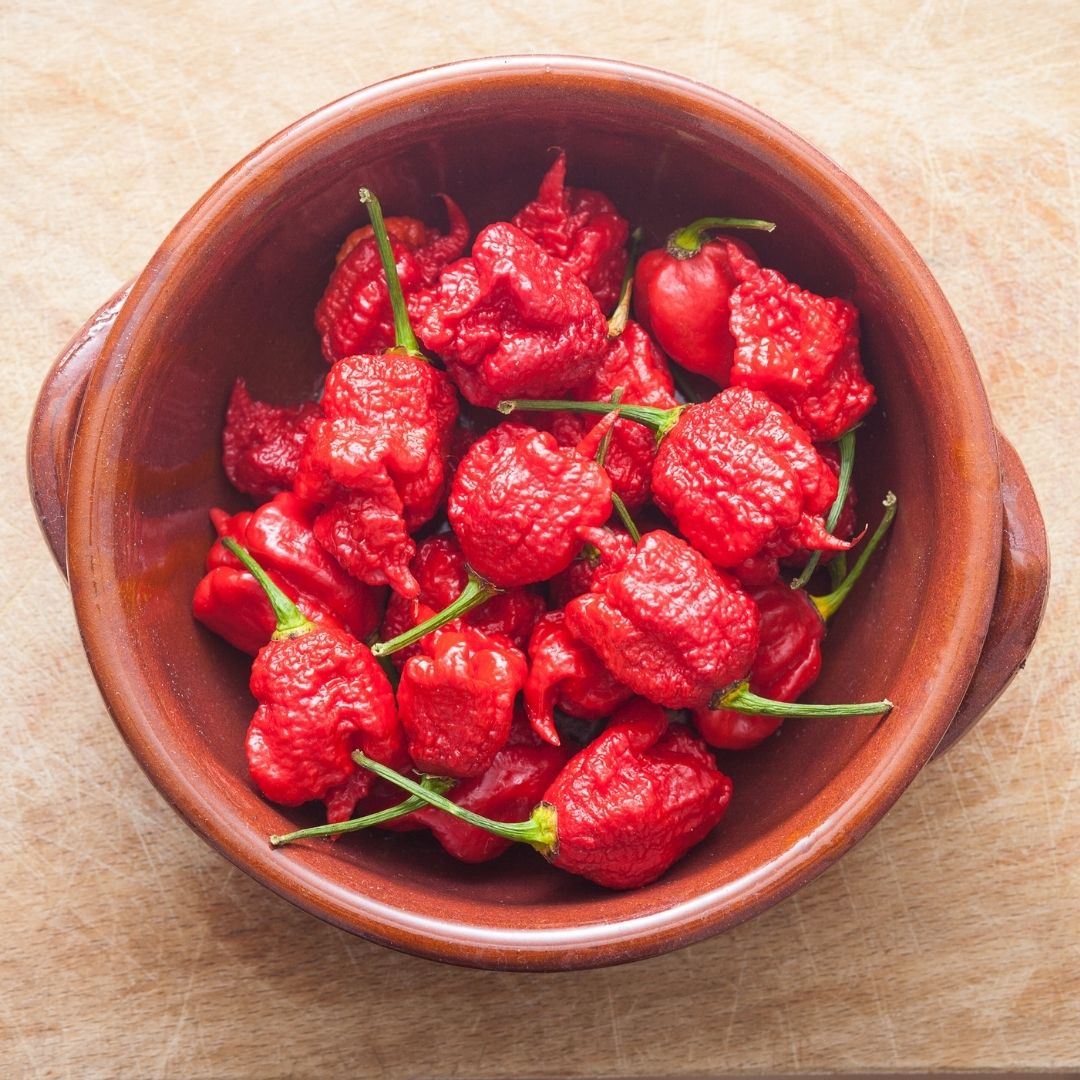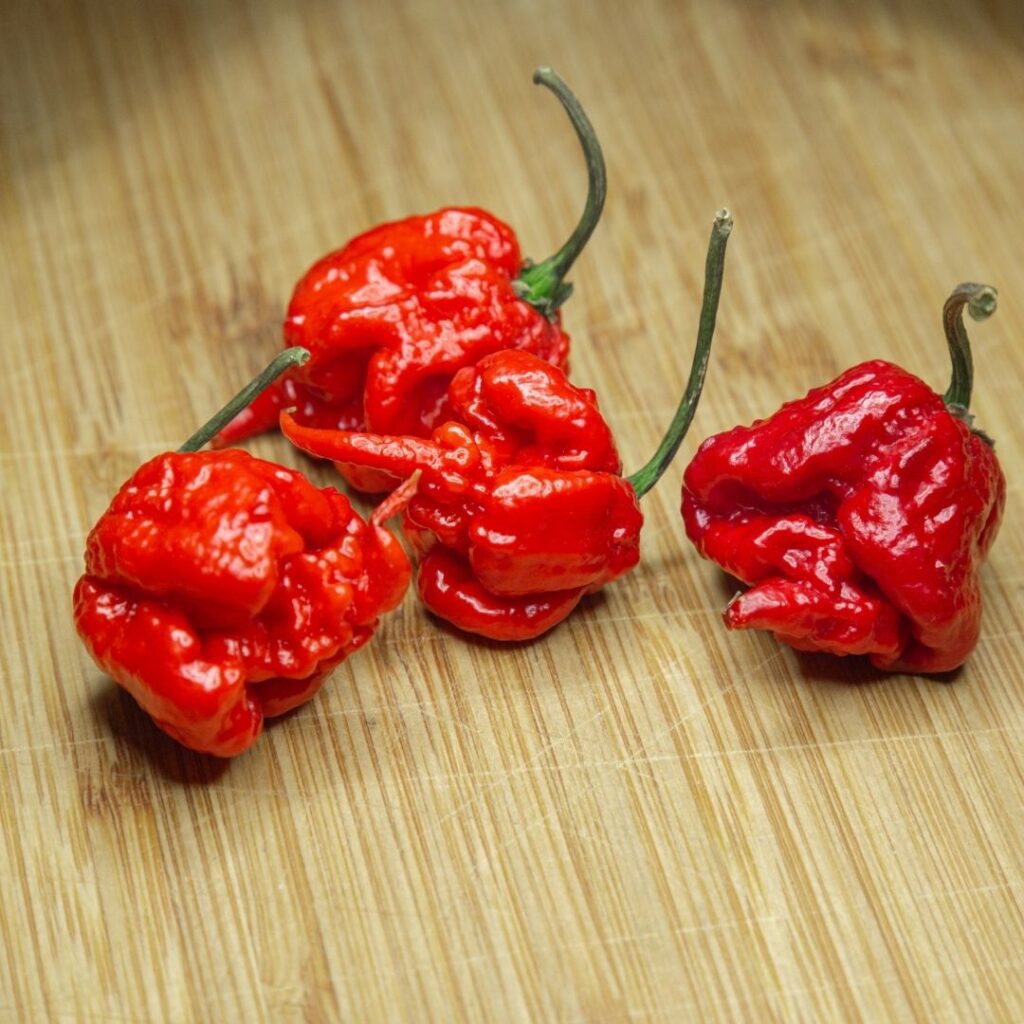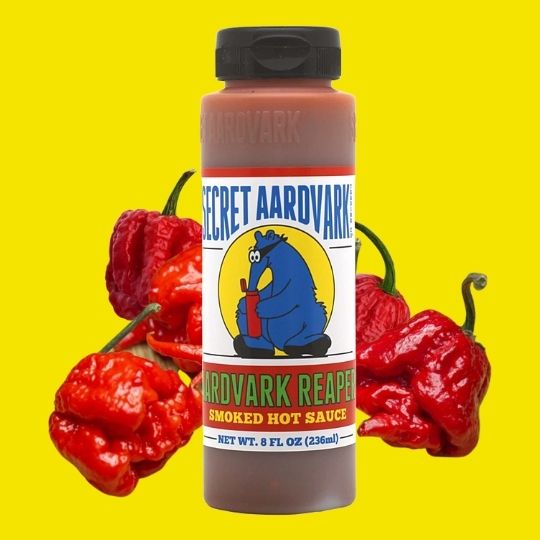
What Makes the Reaper So Deadly?
Here’s Everything You Need to Know about the Carolina Reaper Chili Pepper
The Carolina Reaper’s got a rep.
The Carolina Reaper chili pepper is among the hottest peppers ever recorded on the Scoville Scale—and holds the current Guinness World Record as the hottest pepper in the world!
But that’s not the whole story. The Reaper is also sweet, fruity, and surprisingly packed with flavor. That makes it the perfect combo for folks who want to bring on the heat, but still love the nuanced taste of a delicious pepper. In fact, Secret Aardvark found what we think is the world’s tastiest Reaper and added it to our Aardvark Reaper Smoked Hot Sauce. More on that later.
The Reaper chili pepper is not found in nature.
The Reaper hails from North Carolina, thanks to the efforts of pepper cultivator “Smokin’” Ed Currie. He crossed a Pakistani Naga Viper chili pepper with a Caribbean La Soufriere pepper to create something with even more bite.
As it happens, the Naga Viper chili pepper is also a Guinness World Record-holder. The Cumbria, England farmer who cultivated the Naga told The New Yorker in 2013 that it was, “…hot enough to strip paint,” at 1,382,118 SHU.
In 2013, the Guinness World Book named the Reaper the hottest chili pepper in the world— and currently holds the record, at 1,641,183 Scoville Heat Units (SHU). The hottest individual Reaper pepper was measured at a scalding 2.2 million SHU.
Um, please pass the milk.
That the Carolina Reaper turned out to be even hotter than the Naga Viper surprised even Ed Currie.
“I was just trying to raise capsinoid levels in the Naga [pepper] to see if I could get one of the sub-capsinoids to go higher, and we got the Carolina Reaper,” he said. “It was a gift from God.”

For Context: Reaper vs. Habanero.
For the uninitiated, it might seem like the Habanero is among the hottest of the hot. And in all fairness, the Habanero was the hottest back in 1999.
But compared to the Carolina Reaper? No contest, friend.
The Habanero is tons tamer, averaging 100,000 to 300,000 on the Scoville scale. In other words, the Reaper is an astounding 10 times hotter than Habanero.
Why? The Reaper has a much higher concentration of capsaicin, the chemical compound that registers as thermal heat in the brain. Capsaicin doesn’t literally burn you (i.e., it doesn’t create a thermal temperature change in the body). But it does create a burning sensation. That sensation stimulates pleasure (and pain) receptors in the brain and creates an endorphin rush that chili lovers experience as nothing short of euphoria.
In fact, Ed Currie likens chili peppers to drugs.
“I was on a search for hotter things than I could get, and this was a Vietnamese restaurant that specialized in spicy food, Currie told Wired. “I asked them to make it the hottest they could…and when I ate it, I got a rush,” he said. “I literally got a rush like I was taking some dope.”
“When I first ate the Reaper, it knocked me to my knees,” Currie said. “I was like three years clean [at that time]. I hadn’t felt that feeling in a long time.”
The Reaper: Still the hottest?
The Carolina Reaper is still the Guinness World Record holder. But the bar continues to rise, and pepper-breeding pioneers are rushing to reach hotter heights.
One of the biggest contenders to-date is the Dragon’s Breath pepper, which has measured 2,483,584 SHU. Even the man himself, Ed Currie, has cultivated Pepper X, which reportedly registered 3.18 million SHU. Ouch.
Also hovering near the top of the list are the Trinidad Scorpion Butch T pepper, at 1,463,700 SHU, and the Ghost Pepper (Bhut Jolokia), which comes in at just over 1 million SHU.
Too hot to handle?
Yep. Definitely. No doubt about it: Raw Carolina Reaper peppers will cause intense burning sensations on the skin.
Do not handle them without gloves. You will regret it.
Oh, and if you handle a lot of Reaper peppers, even nitrile gloves may not be enough. At Ed Currie’s farm in North Carolina, the oils from Reaper peppers eat right through those.
Wear eye protection, too. The fumes from cooking with these super-hot peppers will make you ugly-cry. And let’s not talk about it getting into your eye.
But our top safety tip, courtesy of Secret Aardvark Chief Stacy Moritz? If you do touch Reaper peppers, wash your hands carefully.
“You don’t want to touch your sensitive bits,” she says. “Trust me.”
You’ve been warned.
But, hey, don’t literally fear the Reaper.
Google is full of searches from people wondering if eating Reaper peppers will put you in the hospital—or worse (Spoiler alert: you won’t die, though you might wish you did). Most who have eaten a whole Reaper pepper have decided that’s not something they’ll do twice. Other folks squint through the pain and say they’re fine (we’re not buying it).
But don’t let the Reaper’s considerable reputation put you off. It’s also pretty damn tasty.
Okay, what about that flavor?
Adding Secret Aardvark Reaper Smoked Hot Sauce to your favorite dishes is a way to experience the Reaper chili pepper’s exceptional heat and flavor without completely melting your face off. (Well, maybe just a little).
Stacy Moritz took the Reaper Hot Sauce to trade shows earlier this year and invited people to taste it. “I kept hearing, ‘Wow! This is great! I thought it was going to kill me!’”
Aardvark’s Reaper takes the natural fruity sweetness of the reaper pepper and adds a depth of applewood smoke and roasted tomatoes. Its flavor starts deliciously sweet…before it transforms on your tongue into a long, smoky blaze that burns so good!
“It’s hot,” Moritz adds. “But not hot enough to use as a pepper spray.”
Good to know. Because the real secret weapon isn’t the heat. It’s the smoke.
“I love a Reaper pepper—especially a smoked Reaper,” Moritz says. “Smoked Reapers have so much depth to them, which makes our Reaper sauce special. They really blend well with the tomato, carrot, and onion that are the base of our sauce.”
So, if you’re a fan of Secret Aardvark’s signature Habanero hot sauce and ready to run into the fire, the Reaper Hot Sauce will scorch your taste buds in the best possible way.
“Customers were asking us for something spicier,” Moritz says. “Then when COVID hit, like everybody else, I was cooking at home a lot more. I thought to myself, ‘I could use another hot sauce.’”
But she didn’t stop there. In fact, she created three new sauces that are rolling out as we speak: Reaper, Red Scorpion, and Smoky Chipotle-Habanero (You can find them here on our website, as well as on Amazon, with plans to roll them out to retailers near you later this year).
How to Cook with Secret Aardvark Reaper Hot Sauce.
Moritz praises the Reaper pepper for its versatility. It has its place in any dish that could benefit from a sweet, smoky heat.
The sweetness of the Reaper pepper makes it a great way to intensify the flavors of your favorite spicy dishes. Think Mexican, Thai, or Indian. It’s a great complement to Cajun favorites, like jambalayas or red beans and rice. And it adds some welcome heat, sweetness, and smoke for barbecue marinades and wing sauces. For a sweet kick, try it with pasta, pizza, or cheese sauces. Like your Bloody Mary hot? Give it a shot of Secret Aardvark Reaper Hot Sauce, too.

Because a little goes a long way, it’s perfect for spicing up a big pot of soup or chili.
In the meantime? Why not try Stacy Moritz’s Reaper Chickpeas and Greens recipe for an Indian-inspired dish that’s quick, easy, and affordable to make.
Just don’t forget to wash your hands.


